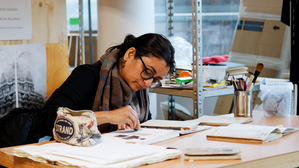New Delhi: One look at the diverse works produced by her over the last few years, and it is not tough to decipher that at the very soul, her engagement with the world comprises layering, erasure, and collage.
Sukanya Ghosh, the Artist-in-Residence at the Senior Artist Residency Programme launched by the Serendipity Arts Foundation and the Royal College of Art (RCA), works through a trajectory of image fragments and tonal complements.
It is the first time in its 120 years of existence that the Royal College of Art, London, has opened its studios to an artist of South Asian origin.
“By juxtaposing different parts of the image and reducing them to a play of line, tone, and colour, I reach a position of abstraction — new landscapes of crisscrossing meanings and overlapping connections.
“While I have been preoccupied with working with discarded photographs from my family archive, I have often used both analogue and digital photographs in my work. I enjoy building up textural and semiotic layers through the use of physical materials such as cloth, paper, paint, thread, plastic, etc,” Ghosh told IANS from London.
Her practice spans painting, photography, animation, and moving images, as her storytelling explores questions of belonging, identity, and place.
For the residency project, Ghosh is using everyday household and grocery lists from her grandmother’s notebooks as a starting point to deliberate on the larger exploration of travel, displacement, and being somewhere else while deciphering the things that ground individuals.
Memory and found objects have always fascinated Ghosh. She feels that what is remembered is a fragile notion, and she likes to play with this to press forward into thinking about the world around us today.
“Found images and objects carry that slight sense of intrigue and excitement because they are ‘found’, which may mean they might have been lost somehow. I like the mystery of this, and the idea that I can play around with the essential meaning of these things,” said the artist who lives and works between Delhi and Kolkata.
Stressing that her ongoing residency experience has been stimulating and invigorating, she added that it is enjoyable being amid a bustling student community and teaching environment.
“I have used some of the splendid facilities that RCA has and most of all I have found so many new and fresh ideas on artistic practice and the making of work. Besides, I have never believed in adopting a competitive mindset.
“There is a place in the world for all artists. Some take time to flower or gain enough confidence in their work. To expose everyone to a sense that one must immediately find a gallery and sell work creates a precarious and dangerously fragile ecosystem,” said the occasional design teacher and arts programme manager.
For Ghosh, spending time at any residency is always enriching, primarily because it provides an immersion into a different space.
This difference can be at diverse levels — a different country, a different cultural context, a different working process, or even a different way of looking at things.
“This provides a critical breathing space in one’s practice – to step back and look at one’s work in another light,” she said.
The artist is spending her time at the residency ruminating on the idea of home, belonging, and identity.
“I am thinking of ‘being away’ and what it means in various contexts, and trying to chart a path that looks outwards at the larger implications of ‘away’. Who becomes a migrant, a settler, or a traveller? And what are the things that denote ‘home’,” she said.
Ghosh, who has always believed in the importance of looking inward to look forward, feels that the intimate and the personal are vital to understanding or even approaching larger ideas. And that artists do not live in a vacuum – and sometimes the way of processing the things that occur around them in the world is to examine the minutiae of their lived experience.
“The path forward is to take these learnings to examine the larger implications of what could be. The past… well, it takes us forward into a new fictional space to think of other things like location and identity,” she added.
While India is witnessing the setting-up of several private art foundations and museums, Ghosh feels considering the size of this country, we need many more public and private ones.
“Only then can there be a discourse on fair practices and equal opportunities. There are certainly many more chances that have opened up because of private foundations and museums. But again, we need more,” she concluded.
–IANS


Comments are closed.